Filmmaker Zach Huber's personal blog www.zachsmothership.com
Don't wanna be here? Send us removal request.
Text
A Shout Out to the Student Director
I think the most glaringly evident thing I’ve learned over these past two years at Columbia College Chicago is that most people think the cinema directing program is the biggest joke at the school. There are very few sets I’ve been on here where someone, anyone, wasn’t talking bad about the director. There are so many times I’ve seen the cinematographer’s or the AD’s having to take complete control of the student sets. There’s even a stigma amongst cinematography students that we’re all unprepared, inexperienced, and unimportant, and frankly who can blame them? Overall as directors our performance is weak. We suck and I think it’s time we admit it so we can move on and continue to do our best to improve. This is not to say that I’m some sort of all knowing directing messiah, because I’m not, I’m just as accountable as each and everyone of us. I merely think it’s important to have open and honest reflection, and with that in mind here are the 5 tips I’ve learned that have made me truly improve as a director.
FOR THE LOVE OF GOD BLOCK THE SCENE.
Block, light, shoot, repeat. This is something teachers here have been drilling into our skulls for years, but do any of us truly understand it? Blocking is probably the director’s most important job on set, and it wasn’t until I took the Directing Techniques for the Micro Feature class that I realized we’re all doing it completely wrong. In the past when I myself or other directors have actually taken the time to “block the scene” it’s looked a lot like this: “Okay everyone rehearsals up, actor A you’re going to start here and actor B you here, okay aaaand action on rehearsal!” Followed by a full rehearsal. Admit it, a lot of us can relate to that, and I cannot stress enough how truly terrible of a practice this actually is. Every time after something like this happens you see the exact same result: the rehearsal concludes, the director moves in and gives the actor’s notes on performance, and afterwards everyone is just as confused as when we started. The purpose of blocking is to rehearse the scene technically so actors can receive their marks and the technical team can be brought up to speed on what’s happening in the scene and do their jobs. Doing a full rehearsal in its place isn’t only confusing, it’s a giant waste of time! It takes longer and by the end of it we have fostered an air of confusion across the entire set that unless corrected, will plague the entire scene. I’ve learned that the most effective way to block a scene is to take the actors and simply physically move them through the scene where they’re supposed to be and show them what they’re physically suppose to do like: “Okay blocking’s up. Actor A you’re going to start here and actor B you’re going to start here, these are your ones. Then actor A walks over here up to actor B, this is your two, mark it. They talk, actor A says “blah blah” and actor B gives him this watch. Then actor A leaves, this is your three.” Done. Now the actors know where to stand and what to do, the lighting team can effectively light the scene, camera is starting to get an idea of what you may want for the first shot, sound knows roughly where to stand for the first shot, and no one is confused. After that, and maybe the most important part of this entire equation is “repeat”. This is something we have to repeat before every shot. There are so many times on set I see directors say “great moving on” and then just stand there and wait. What are we waiting for?! It’s our job to drive the set forward, it’s our job to tell everyone physically what to do, we’re the bosses and it’s time we started acting like it.
TOO MANY QUESTIONS, NOT ENOUGH ANSWERS.
The next lesson I’ve learned kind of piggybacks off the last one. As directors we’re the people that know what it takes to bring these films to life and it’s important that we share that knowledge clearly. The most frustrating thing I hear most of us directors say on set is “yeah whatever you think.” That’s not to diminish the creative process of collaboration, because I do believe that has it’s necessary place on set and we should be open to how other’s ideas can improve our product, but I think too often directors say this to alleviate the pressure of having to make one more decision. It feels like so many of us are uncomfortable taking the full weight of having creative say over everything, that so many of us are uncomfortable directing people, and it comes off to the crew as though we’re incompetent and unprepared. I know directing is a tough job, it takes a lot work to get a satisfactory product, but that’s a responsibility that as directors we’ve already accepted and we owe it to the crew to deliver. I see so many of us time and time again asking questions when we should be the people answering them, and if we want to be truly effective directors then we need to start answering questions before they’re even asked.
STANDARD COVERAGE IS YOUR BEST FRIEND.
This is a statement I know isn’t going to sit well with most of the student directors here, and hell, a year ago it wouldn’t have sat well with me either. I get it, we all go to art school and we all have our own valid opinions, but one of the most important things I’ve learned is that at some point we all need to realize that right now we’re not going to be the next Stanley fucking Kubrick. Someday? Maybe, but as directors I think we need to understand that the filmmakers that we all idolize, whomever they may be, are masters of a visual language that we’re only beginning to understand how to speak. By imitating them and trying to come up with these convoluted shot compositions that we think fit our stories, we’re effectively trying to run before we can walk. Instead, we should take a step back for a moment, and take an objective look at our films. The hallmarks of just about every student film I’ve noticed are: Weak stories grounded in emotional exposition that’s suppose to carry thematic weight, hacky shot compositions that are suppose to support those themes, and ultimately, films that are confusing and boring as hell. From my personal experience I’m here to tell you that as a director the day I contented myself with standard coverage was the most liberating day of my entire life. By freeing myself of the pressure to express myself like a master and instead reinforcing the basics, I allowed myself to explore what I’ve learned is truly important in the art of cinema: the subtleties.
IT IS NOT OUR JOB TO IMPOSE OUR VISION ON THE ACTOR
There’s a lot of subtleties we as filmmakers manipulate on set. Set design, colors, lens size, camera movement, the list goes on. However, as directors one of the most important subtleties we have control over is the acting, and that’s a creative device that I’ve seen a lot of student directors surrender unknowingly in more specific ways than I’ve previously explained. Most student directors I’ve watched, and I know all of us are guilty of this at some point, lose out on the chance to work with their actors on crafting a truly subtle performance because they’re constantly bogging them down with useless information. How many times are we going to call cut on a take, go up to an actor, and painstakingly explain their character and their character’s motivation to them until we’re blue in the face and they’re dizzy from following us? I’ve come to think that talking at our actors like this and imposing our vision on them isn’t just confusing, it’s simply not our job. If we want to explain to an actor how their character should be then we should write a good story that the actor can interpret. The writers tell the actors how their characters should be, and I think it’s the director’s job to take what the actor has interpreted and make it the best it can possibly be. I’ve learned that we can and should do things like: Inspire the actor’s performance with specific action verbs, adjust their eyelines to make them more accessible to the audience, and help them find the light. All these terms are ones that actors are trained to work with, and if we want the best results then we need to start working with them as well.
THE ULTIMATE FINAL SUPER MEGA LESSON… OF DEATH!
Being a person is tough. We’re constantly trying to jam pack our lives with stimulating experiences we can remember fondly, while also balancing a professional life that has a lot of incredible demands both mentally and physically. While filmmaking may be one of the most demanding things I’ve ever done, I think the most important lesson I’ve learned over these past few months is to simply smile and enjoy myself, because it’s contagious. Weeks ago I showed up on set royally hungover from a celebratory night out with my cousin for his engagement. It’s safe to say I was in a god awful mood. The entire day I was napping in my own lap and counting the seconds until I could leave. It came down to the final stretch, two hours left, and head pounding, body sweating, I was in no mood to make films. However, right then something happened that I will never forget. The director came on and she just naturally emitted this cheeky excitement for her own work. She was smiling and having a good time, and it didn’t take long for my mood make a complete 180. As directors we have so much power on our sets. Every decision we make from how prepared we are, to how we interact with people on set, fashions a mood and morale for the set that isn’t just vital to our final product, it’s vital to us and our human experience. On the flip side of that, a few weeks after that I was on maybe the worst set I’ve ever been on. It was all exteriors, freezing cold, and the director was not only completely unprepared, they were incredibly unclear about what they wanted. Naturally this became one of those sets where “everything that could go wrong did go wrong”, and it left me with one final lesson to pair with the one I just mentioned. That is: The world does not need us. The world needs doctors, and scientists, and inventors, but they tolerate us because we’re entertaining and facilitate important discourse, and everyday that we get to wake up and make films is a true blessing and something we should cherish… Also if you want to be a director for the love of god grip on a few sets.
0 notes
Text
Who’s the Real Idiot Here?

Today just happens to be one of those days where I feel like a complete fucking idiot. The anger boiling inside of me, making my toes curl and my teeth clench. At one point I sincerely wanted to stand up, scream, and thrust my limbs all around me in a frenzy like the crazy guy sitting across from me on the train, but for what? I don’t know, but this is an all too familiar feeling. My mind racing, thinking about how much “I fucking hate the Blue Line” and how “I’ll never live off of it”. But the train is just a scapegoat. A misguided target of my rage that really should be directed at myself. It was my gross incompetence in this moment, taking the train the wrong way for 8 stops and missing the meeting with one of the most promising artists I've ever met, that truly pissed me off. I find it interesting how anger can blind me. There was a moment I genuinely believed it was the trains fault, foolish enough to ignore the disappointment I am to myself and instead seeking out a scapegoat. Playing the victim. Is it because that’s the only way I feel like I can justify my anger? That I only deserve to be angry if I’m the victim of something outside my control? Again I don’t have the answers, but I will say this: Once I finally admitted that I was really angry at myself, that I was in control, that’s when I was able to move on. I think by playing the victim in a situation like this all I was really doing was contradicting myself. Instead of empowering myself, I was dragging myself and everything around me down. So who’s the real idiot here?
0 notes
Text
Filmmakers - Listen to your Elders
One of the biggest bummers about current Hollywood films for me is the lack of meaningful and interesting shot composition. It seems anymore that most films just resort to close up handheld shots and it's getting visually boring. This past semester for the first time I was subjected to studying the films of John Ford. A lot of people in todays time just write John Ford off because the Western by in large is a dated genre that doesn't appeal to them, but for us filmmakers it's important to note that John Ford is in many ways one of the, if not the greatest, American directors of all time. For that reason I've decided to upload the recent essay I wrote over him analyzing his style in depth so that todays filmmakers can be more aware of the creative ways they can compose shots.

John Ford: Scientist of the Wild West
John Ford makes films like he’s boiled filmmaking down to a science. That may not sound like an outlandish statement considering Ford directed over 100 films, but Ford’s scientifically precise filmmaking doesn’t just come from experience, it’s his style. For some reason Ford is often overlooked in modern conversations about auteurism even though he has so much to offer in the way of auteuristic style. It’s probably because most people think that his precisely executed character driven shot composition is just the “invisible style” common in the classic Hollywood film era, something that couldn’t be further from the truth. Film critic Tag Gallagher describes John Ford’s style saying “it’s more like the 18th century portrait in oil, a cameo, a vignette, overloaded with detail” (Gallagher). He even goes on to conclude that “Ford is the best director in the history of motion pictures because his placement of the camera always made even good dialogue unnecessary or secondary.” (Gallagher) Ford no doubt has an intricate style, and by expounding upon it through the analysis of some of his best films it will become clear how he uses shot composition to thoroughly support his character development.
When discussing John Ford’s style the word “precise” gets thrown around a lot, but what exactly is it about his style that expresses such precision? He has a natural, quick, and in depth way he portrays his characters. Ford floods the screen with so much information about his characters that he can develop them quickly and more in depth without ever confusing the audience (Gallagher). Part of that is simply his ability to stage and direct actors, but far more pertinent to the precision his films exhibit is the shot composition he uses to accentuate his character development. Take the beginning scene in Stagecoach when Lucy Mallory first arrives in Tonto, for instance. In this scene Lucy is on her way into a hotel to get something to drink when she’s intercepted by a couple of her friends.

Ford uses a wider shot and cleverly places Lucy here with her back to Hatfield so that he can characterize both of them at once. Then, as Gallagher describes, he uses just a mere series of glances exchanged to show the audience just exactly who these characters are (Gallagher). The silent contemplation Hatfield shows in this shot goes a long way to characterize him as a mysterious man, and that is only affirmed when Lucy finally turns around and he silently greets her as she walks by. By capturing that and Lucy’s pompous reaction to his otherwise friendly gesture in the same shot, Ford decidedly characterizes both of them in a very short amount of time. He then continues on that note as Lucy and her friends go inside to sit down and gossip about Hatfield.
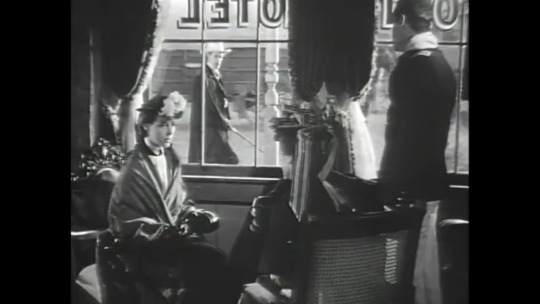
Here he again develops Lucy through the dialogue she has with her friends, and adds another layer of mystery to Hatfield by having him stare longingly through the window. By composing shots with multiple characters in them Ford not only develops characters faster, but with the added screen time can explore them in more depth. Ford’s precise style stems primarily from this type of shot composition, but it’s not the only trick he has up his sleeve.
Ford does not just limit himself to using characters to develop each other within the same frame. Instead, as Gallagher suggests, Ford often uses character’s reactions to develop other characters before the audience even knows what they are reacting to (Gallagher). In its simplest form this can be seen in My Darling Clementine when Doc Holliday is first introduced.

At this point the audience already knows that the man to the left is some greedy upper class citizen, and that Wyatt Earp is, for the lack of a better term, a bad ass. So when the greedy townsman stops shoveling in his chips abruptly and Wyatt diverts his attention across the room, the audience knows what they’re staring at is cause for concern. When the next shot reveals that what caused these reactions was in fact Doc Holliday, Ford immediately establishes Doc as this strange, dangerous man. He informs the audience on how to feel about Doc before even showing him on screen by showing how other characters feel about him first. Ford uses this precise technique to cut a lot of fat out of his character development; however this method is comparatively shallow in relation to the other methods he is known to use.
Close-up shots have always been a way for filmmakers to command audience attention and focus it on elements of the film that they deem important. Today most modern Hollywood films are shot primarily with close-ups, which is something that almost completely devalues the original point of using close-up shots all together. This fact is something Ford is noticeably aware of, as the first real close-up in Stagecoach doesn’t even come up until the corrupt banker Gatewood is introduced around the six minute mark.

Ford starts the scene off with this three shot, which allows the audience to get somewhat of an idea about who Gatewood is through the way he interacts with these men. Gatewood seems poised and professional, assuring them that “what’s good for the banks is good for the country.” Although seconds later when the other men leave and Ford goes in for a close-up, the audience is finally allowed to see past Gatewood’s facade and get a true look at his character.

This one close-up stands out as an emphatic point of characterization, and focuses the audience in on the bad intentions written all over Gatewood’s face. Ford knows that by only using close-ups in choice times like this, the close-ups become a way for him to cue the audience in on more important character developing moments. John Ford uses close-up shots to develop his characters in deeper ways than just that though, something that again is clearly evident in My Darling Clementine when Doc Holliday is first introduced.

Doc is cold and emotionless in this scene, and at this point the audience hardly knows anything about him. He is one of Ford’s most cryptic characters, and part of the reason he feels so mystifying to the audience is because Ford chooses to introduce him here primarily with close-ups.
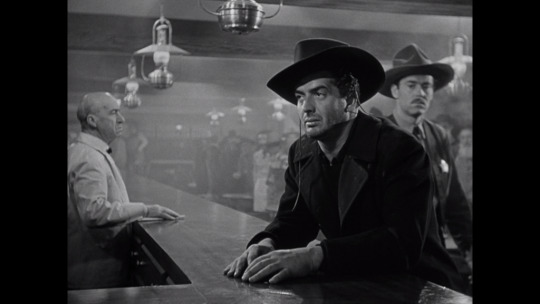
These close-ups draw increased attention to his character, but his cold demeanor doesn’t give the audience anything to grapple with. This subconsciously fosters feelings of unease for the audience and ultimately makes Doc seem that much more mysterious. Ford’s style seems so precise here because he does not just show audiences who his characters are, but makes them feel who they are, and in fact that’s a trend Ford follows with other aspects of shot composition as well.
If Ford uses close-ups sparingly then it’s safe to say he practically never moves the camera. He uses moving shots so infrequently that even one that was out of focus was powerful enough to launch John Wayne’s career (The Creation of John Wayne). Similar to his disciplined use of close-ups though, it is not just the frequency with which Ford implements moving shots that makes them so effective, but also how he utilizes them. Ford almost solely moves the camera only when the characters in the scene motivate him to do so.

Like this shot in Stagecoach when he tracks backwards with Dallas so he can follow her while the townspeople walk her out of town; or perhaps this scene from My Darling Clementine when he pans across the room so he can follow Chihuahua as she walks away from Doc Holliday.
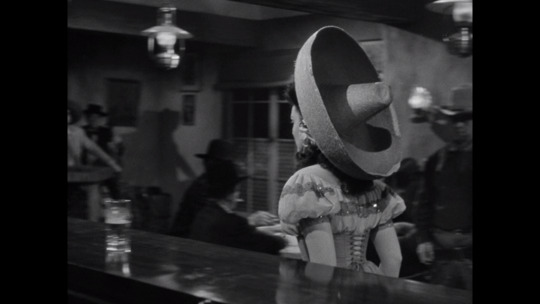
Ford reserves the majority of the camera movement for moments like those, and in turn makes the few moments where there are not distinct reasons for camera movement much more impactful. This is evident in this scene in Stagecoach when Ringo and Dallas are at the dinner for instance.
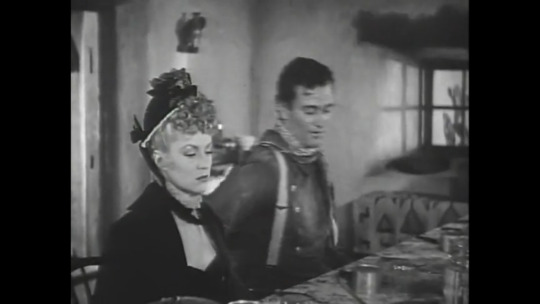
Gallagher discusses the power of the camera movement in this shot explaining that “the way the camera moves in on Dallas makes us feel feelings even before we know their reason. In movies it’s feelings that produce ideas, and the camera movement makes us feel these feelings like a weight.” (Gallagher) Ford tracks in on Dallas here to make the audience feel the humiliation she feels in this moment, and with that simple movement emphasizes this key beat for her character. Similar to the way Alfred Hitchcock played inside his viewer’s subconscious to create suspense, Ford has mastered a way to do the same in relation to the development of his characters. So much of his style operates outside of the movie itself and that is ultimately what makes his style feel so precise.
When expounding upon John Ford’s style through Stagecoach and My Darling Clementine it is clear that Ford’s character development is seeded deep within his shot compositions. He uses techniques like composing shots with multiple characters, introducing characters with reactions, close-ups, and camera movement to focus audience attention on pertinent character moments and deepen the development of those characters. John Ford’s films feel so precise because unlike a majority of other films he specifically picks the simplest shot compositions that succinctly inform the audience on the characters he’s engaging with at any given time. Without a doubt this ability to compose interesting character focused shots makes Ford one of the most legendary directors of all time. Ford is a wild western scientist creating tight and thoughtfully composed cinema for the masses, and these are his formulas.
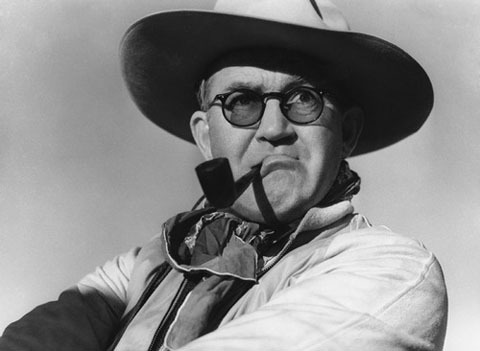
Works Cited
Gallagher, Tag. "Dreaming of Jeannie: Tag Gallagher on Stagecoach." Vimeo. Web. 25 Apr. 2016.
Stagecoach. Dir. John Ford. Perf. John Wayne. Released by United Artists, 1939. DVD.
My Darling Clementine. Dir. John Ford. Perf. Henry Fonda. Twentieth Century-Fox, 1946. DVD.
The Creation of John Wayne. Dir. John Cork. Criterion Collection, 2008. DVD.
0 notes
Text
Some Insight on Directing (Spring 2016)
There's been a lot going on in these final weeks of the semester. Writing papers, filming shorts, letting SAG-AFTRA cake fart your face. That's a lot of "experience", and through those experiences I've been able to distill my thoughts and notes down to one piece of advice that I think can immediately improve anyones ability as a director.
Don't tell your actors how to be, tell them what to do.
It sounds simple, but it's a major pitfall that I see in a lot of directors. Don't tell you actors to "be more angry", tell them to attack someone, insult, seek revenge, etc. Telling actors how to be is just confusing and vague, don't be such a lazy chode. As a director, by telling actors what to do you immediately up your game to a level of specifics that forces you to be more involved with the story you're trying to tell. If you're going to find the perfect verb that's going to inspire your actor to look exactly how you see them in your head, then naturally you're going to have to fully develop and understand that vision in your head first. You have to determine who you're characters truly are, what makes them that way, their main motivations, their needs, their obstacles. Then in turn, how all those interact to develop the the narrative you're trying to tell and the theme you want to get across to the audience. Just by changing the simple thought process behind the way you talk to actors you can save yourself from being one of those confused directors that can't find any takes they're truly happy with in post. Develop your vision, trust it, and find ways to actively draw it out of your actors, rinse, lather, repeat.
0 notes
Text
Dj Trapook Shoot
I've been working a lot lately trying to experiment with different kinds of lenses so I can take my filmmaking to the next level, and did a photoshoot with my roommate yesterday to play with a new telephoto lens I got. With that said I'm super stoked about how the photos came out! The Canon camera I have has a feature that takes raw photos and allows you to edit the camera settings after the fact, which gave me some great control in post. My roommate played a character in the shoot he named DJ Trapook, a douchey eccentric trap music dj, and you can check more out about him @staffhipp on twitter! Enjoy!
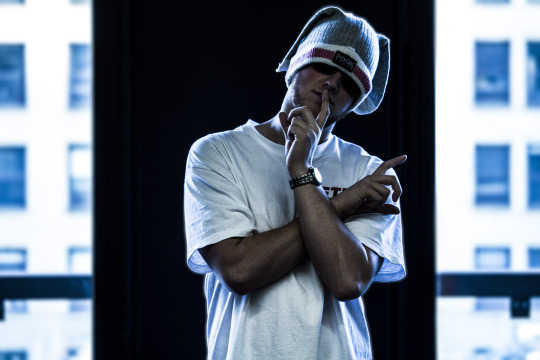
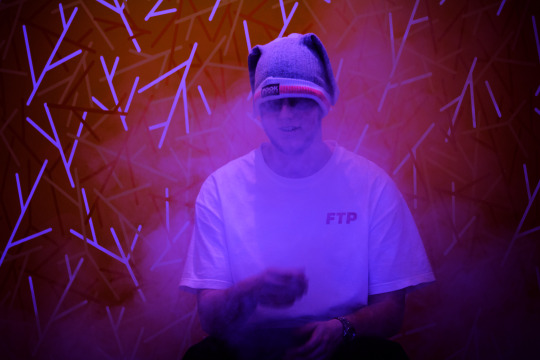
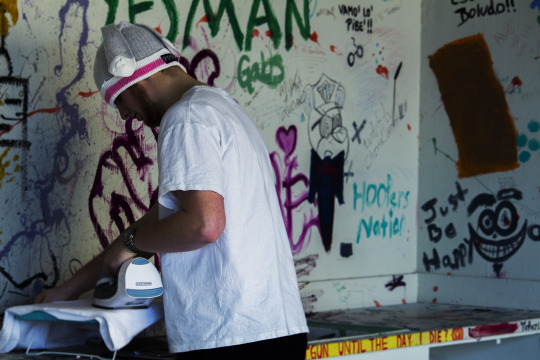
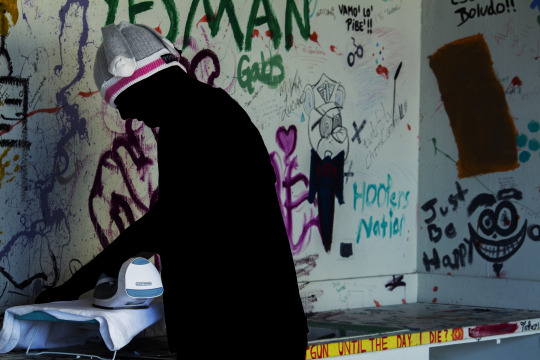
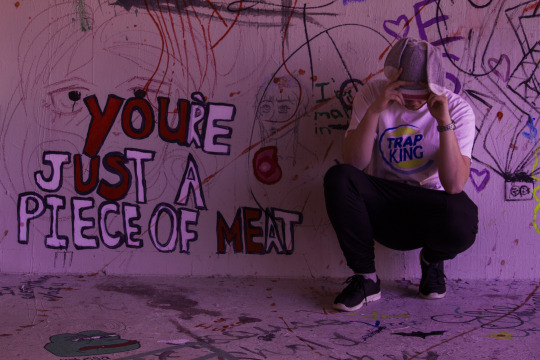
0 notes
Video
tumblr
"Don't Piss In the Shower" is one of the first comedy videos I made when I first started experimenting with filmmaking and it undeniably still holds a special place in my heart. Since it was one of my first videos the quality is a little lacking, it is really over exposed at times, but it came before I really had any experience or knowledge of filmmaking. However now that I've been learning a lot more about filmmaking, comedy, and my personal tastes it represents what I think is a natural ability and passion for creating absurdist comedy.
0 notes
Text
The Hateful 8: Trying To Make America Great For Once (Winter 2015)
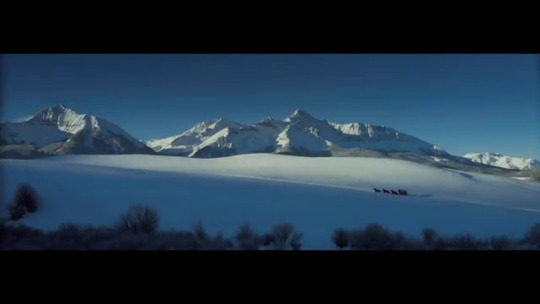
Wow. That’s the one word I would use to describe “The Hateful 8” after first experiencing it. I have to admit I went into this movie pretty blind, I hadn’t seen a trailer or even heard what the movie was about, all I knew was that it was filmed in 70mm Panasonic Film and that it was renowned director Quentin Tarantino’s next big film. I had no idea what to expect, but what I got was much more than I could have asked for. Be warned now this post is going to have spoilers, because it’s not intended to review the movie (It’s Tarantino just go fucking see it). No, what this post is concerned with is what Tarantino intended for this film to do, inciting discussion over the racial issues that have and continue to plague the United States.
A lot of reviews I have seen so far over the movie criticize Tarantino for using this really wide film format to capture what is mostly non-landscape scenes, and while he may not use it for that reason, what these reviews are completely missing is the jam packed and insightful subtext within the cinematography itself. This movie is a full comment on the current racial tension that has been climaxing lately in the United States, including identifying the roots of our problems and offering a solution. This all started to become clear to me in the beginning of the movie with the scene right after Sheriff Mannix gets into the carriage with Major Warren, John Ruth, and Domergue. Here, Mannix, a former confederate soldier, and Warren, a former Union Soldier, get into a huge argument over the war, an argument that felt very relevant and referential to the racial issues in today’s time but also seems to be a representation of the civil war they’re arguing about. I got this feeling not only from the dialogue and the hateful speech they used, but also from the cinematography. The Panasonic film does a great job of capturing both the men’s skin tones and for that reason you get a clearly defined white versus black aesthetic in this scene, as they’re both framed literally on opposite sides of the wide screen facing each other. Here in the very beginning Tarantino uses this scene to set up the fact that these racial issues we’re dealing with today run parallel to and stem from the ones caused by the civil war, but with that said that means he also uses this scene to establish Major Warren and Sheriff Mannix as metaphorical representations of the American white and black populations respectively, something that’s going to come into play a lot during further discussion of this film.

A lot of reviews over this movie also criticize Tarantino for his graphic use of violence and profanity (particularly the n word), and while most people are eager to just chalk that up as Tarantino being Tarantino, I think it actually plays into Tarantino’s deeper message behind the film when you examine it against other the characters metaphorical representations and how they interact.
I’ve already established that I think Warren represents the American black population and Mannix the American white population, but two other important representations I think come in the form of Ms. Domergue and old general Smithers.
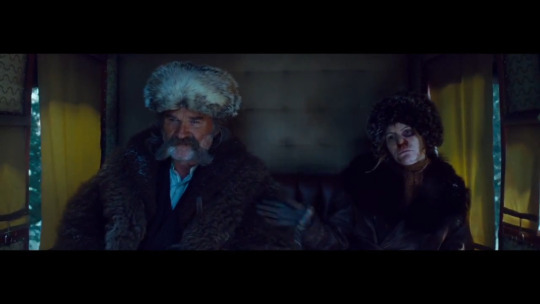
Domergue I believe is a representation of pure hate and evil. I think this is most obvious to me because first off Domergue fuels the argument between Mannix and Warren in the stage coach. Much like the pure hatred of someone’s skin color that fueled the civil war, Domergue influences Mannix in this scene, getting him worked up and at arms with Warren, something she continues to do throughout the movie. It is hate just like this that I think Tarantino believes is one of two contributing factors to todays continued racial tension.
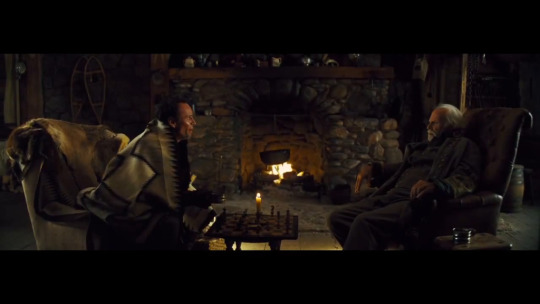
The other factor I think Tarantino believes is a contributing factor is represented by General Smithers, and that is the United States history of racism. Not only because he’s old and because he’s a former confederate general, but because of the influence he also has on Mannix’s character. You see, because once they get inside the cabin the respect that Mannix has for Smithers is what actually incites a lot of the conflict he has with Warren in those scenes. With Domergue being pure hate, Smithers being past racism, and the influence they have on Mannix’s conflicts with Warren, Tarantino is certainly making a statement here that these two things are the main contributing factors to our racial issues we’re struggling with today, and if we continue to examine how each of these characters interact we can decipher the message Tarantino wants to get across to us.
First off it is important to note that while Mannix (and ultimately the white population) is under heavy criticism by Tarantino in the film, Tarantino doesn’t go as far to make Mannix into the bad guy and Warren the good guy, but actually criticizes Warren equally. You see this in the stage coach when Warren gets so worked up by the hate Domergue represents that he punches her out of the stage coach, almost hurting his innocent friend in the process. Not to mention the hateful acts of revenge he committed because of the historical racism that Smithers represents. There isn’t a character you can root for in this movie because no bodies right! Black or white either way we’ve all been wrong during these past years of heightened racial tension and that is part of what Tarantino is getting at.
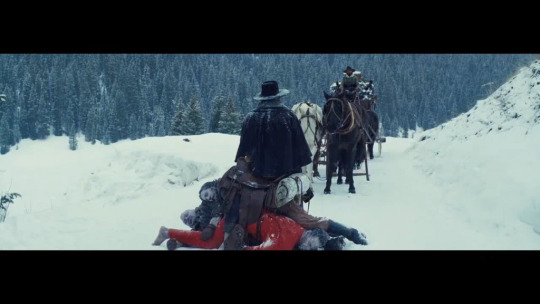
However Tarantino then takes this commentary a step further by actually offering up some advice to the American public. When Warren then kills General Smithers Tarantino is symbolically challenging white people to stop allowing the racist tendencies of their ancestors to dictate the way they think, and challenging black people to stop dwelling on the past wrongs that have been done to them. Continually, at the end we watch as Domergue and the hate she represents tries desperately to pit Warren and Mannix against each other, but it’s their resolve to rid themselves of that hate that has them symbolically hang her (ridding themselves of it) and then laughing together as they slowly die.
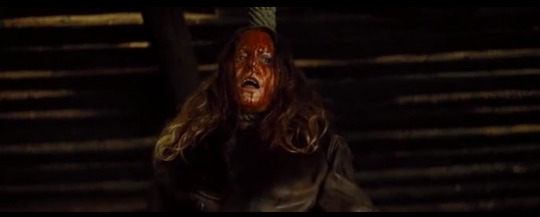
While those challenges to move forward and destroy the hate between us is a strong and relevant message in its own right, I actually think it is the graphic nature of the film and the fact that everyone, including Warren and Mannix, die at the end that is what makes it so potent. I think Tarantino made the film so graphic with violence and language because that’s the same things that are happening in real life! It’s actually crazy to think that people are reviewing this movie and thinking to themselves how horrible the language and violence is, when that’s only a fraction of what is actually going on out there! People are using this profane language to offend each other and ruthlessly murdering each other just like this in today’s world and Tarantino is not shy about showing us that here. Along with that even though the end is hopeful in that Tarantino proposes a solution and shows a way to solve these racial issues, he also warns us that at the rate we’re going it's going to be too late and we’re all going to end up wounded or worse dead, like every character in the movie.
With “The Hateful 8” Quentin Tarantino has given us what I personally consider to be his most incredible and relevant work yet. More than that he has offered a much needed objective social commentary over the racial tension in the United States in a time where it may be more necessary than ever. Many reviewers have been quick to write this movie off and I’m assuming it’s because they’re looking at it under the same scope they do for the mindless corporate films Hollywood has been putting out for the past decade. Bottom line? “The Hateful 8” is a daring piece of cinema that not only Hollywood but the American public needed, and it’s time for the change it endorses.
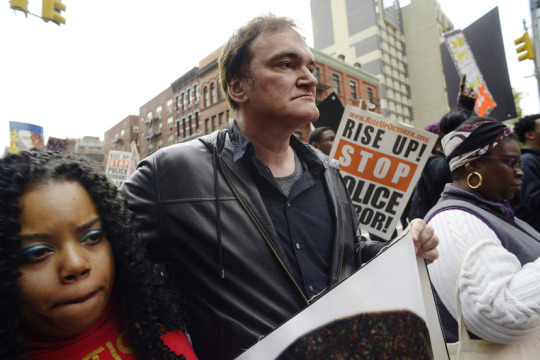
0 notes
Video
youtube
The Upper Hand is a no dialogue piece about a man that obsesses over giving a good handshake.
This is the second film I turned in for a class here at Columbia and this time I worked with an assigned team. I wrote and edited the project, and through the course of it learned that when it comes to filmmaking there’s a reason people have such specified jobs, and that to be the most successful you have to have unified direction and people that play their roles.
Also if you're like me you think that noise that comes out of Chris' mouth at the end is the most ridiculous unatural sound... BUT IT ACTUALLY CAME FROM A HUMANS MOUTH! Here's the link to the sound effect on free sound ( http://www.freesound.org/people/vikuserro/sounds/246309/ ) If anyone out there ends up doing anything with it post it here or let me know! I will follow that sound anywhere lol.
0 notes
Text
Some Notes About Comedy and the Art of Being Offensive
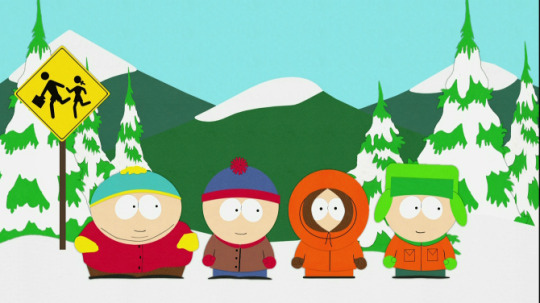
Lately I've been working on a fairly big paper for my Next Generation Cinema class about South Park and how and why it's able to push peoples boundaries. I've been reading the book South Park and Philosophy by Robert Arp for research and it has given me a lot of insight on comedy as a whole and helped me form my own ideas about comedy and what potential it has that I would like to share.
Comedy at its highest level, satire, is social commentary. This is something any good society needs, because if you want to have a happy society you have to be able to have open and uncensored discourse within it. Just think about totalitarian states like the U.S.S.R. or North Korea, these places are so miserable because they don't allow people this right. In that way comedy not only makes people happier by making them laugh but by starting discussions about important topics in our society.
A lot of people criticize South Park because they use blasphemous and really vulgar humor to illustrate their points, but we as a society have to realize that if we expect people to give commentary on our society and tell us like it is then not only can we not censor them, but we can't get offended when they in turn actually tell us like it is. South Park doesn't care whether people get offended or not and that's what good comedy has to do. If you truly want people to change their ways, like your social commentary aims to do, then you have to find a way to actually get them to talk about it, and that's where the blasphemy comes in again.
In a certain sense as a comedian you have to be offensive just to get people to talk about things. The people that aren't offended by your jokes get your point already, and the people that are offended are going to let their voices be heard and get a conversation over the matter started, and for that reason offending people can actually be beneficial. It has to be noted though that humor that's just offensive for the sake of being offensive doesn't deserve this grace. Without a solid message intended to get across to the audience blasphemous humor is just plain mean, and that's not what South Park or good comedy is about.
There's also other ways people can use offensive humor to spark discussion and ultimately influence peoples views. Even if your offensive humor is wrong you can still use it to your advantage.
Take for example misogynistic jokes. In my time as a comedian there is nothing that has been more annoying to me than a person that takes the stage at an open mic and just fires off awful misogynstic jokes killing at least half the audience. However wrong this misogynistic humor is though it can still be used advantageously to change peoples viewpoints. As a comedian you could use this humor to target and engage audiences that find this type of stuff funny. While people that laugh at something don't necessarily have to believe in the ideas it represents, they just have to understand them, we're going to assume that most people that laugh at this do in fact hold those misogynstic beliefs. With that said you can then take that misogynistic audience that you have thoroughly engaged and then turn their viewpoint completely on its head. If this counter point that you have created in the form of a joke is clever enough it just might get that audience you have captivated to think hard about the beliefs they hold and can even spark discussions. Also on the flip side of that because it was offensive it could also get the people that disagree with it to start a discussion over the matter, so now with one string of jokes you have successfully engaged both sides in an argument with the potential to change peoples viewpoints!
I've found myself coming to the conclusion that for me comedy IS pushing peoples boundaries, comedy IS making social commentary. But regardless of whether you agree or not I think it's obvious that comedy is an incredibly powerful tool, and the better we know how to wield it and how it effects people the more influence we can have over them and each other.
0 notes
Video
youtube
The very first film I made upon coming to Columbia, Vigilante VHS is a comedy short about a vigilante justice that combats climate change denial by throwing VHS tapes at people. Being the producer, director, and cinematographer, this project taught me a lot. Namely how much dedication it truly takes to make a film, and that I needed a cinematographer.
0 notes
Text
Artist Discovery: Rainer Werner Fassbinder (Fall 2015)
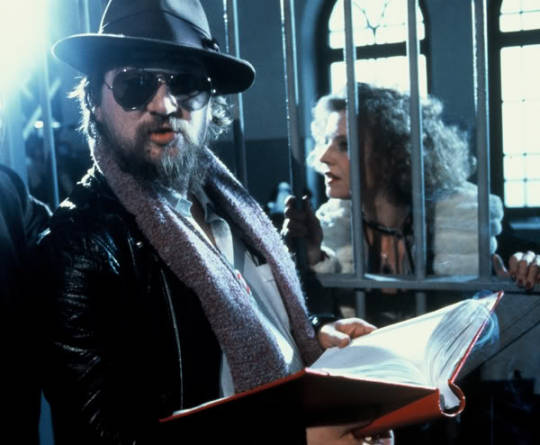
This semester in school I took a World Cinema 2 class and for the first time have been exposed to a lot of the critically acclaimed foreign films from over the years. Now that the semester is beginning to come to a close I can say without a doubt my favorite filmmaker examined over this course was German New Wave Director Rainer Werner Fassbinder. This guy was crazy! He only had a 14 year career, ended by a cocaine overdose, but in it he created 40 feature films, 2 tv series, 3 shorts, 4 video productions, 24 stage plays, and acted in some 36 films (I can feel people reading this starting to justify cocaine addiction in their heads).
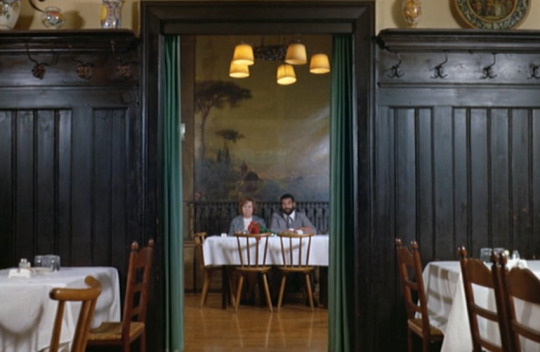
He was involved in every aspect of production and had unheard of levels of production. Not only did he often times complete his projects on schedule and under already miniscule budgets, but he didn't sacrifice quality either. His color schemes are vibrant and complex, his shot selection is inspiring, and his material has plenty of strong messages. He has some of the greatest foreign titles under his belt "Ali: Fear Eats the Soul", "The Marriage of Maria Braun", and my personal favorite "Beware of a Holy Whore", in which he satirized himself and his film crew in a movie where they all play each other.
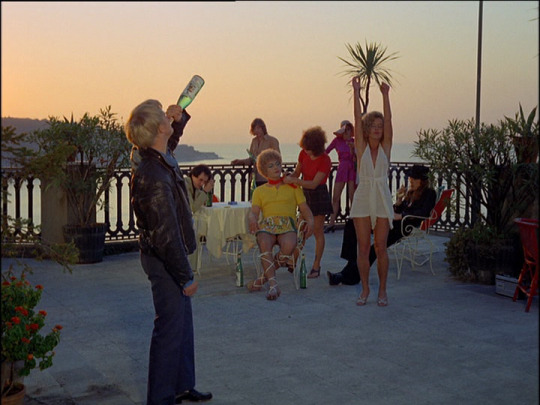
He never ceased to provoke people either, he was best known for his open homosexuality and controversial behaviour. During his career he garnered so much news attention because of his controversial work that he was almost constantly being criticized and examined by people in Germany. He is the true definition of a renaissance man in the artistic industry that embodies every other art form within it, and that's why he has been such a huge influence to me. I'm learning that he embodies everything it is I want to accomplish with my career, I too want to be involved in every aspect of production writing, directing, acting, and editing, and his creative energy and provocative work is something I strive to capture myself. He did everything with nothing and brought national attention to his birthplace, and if I have my way by the end of my career I will be able to say that I did the same.

#filmmaking#filmisnotdead#german#german film#rainer werner fassbinder#artistspotlight#artistdiscovery
0 notes
Video
tumblr
Sometimes in life we are confronted with problems that dwell in the realm of supernatural. On July 28th 2015 at the Tank Room open mic in Kansas City, Missouri I was confronted with such an issue. Right before the host Rashaad Wright could call me up on stage a strange "wandering traveler", presumably high on crack cocaine entered the bar and began loudly professing to the entire bar that he was indeed a monster, specifically the infamous Godzilla. Raashad was somehow able to get him to quiet down and eventually he left presumably to terrorize the city. However when I took the stage he climbed back up from the radioactive depths of the alley he sleeps in and interrupted again, this time smoking a cigarette in the bar. I was fortunately able to subdue him slightly and after my set he was adamant that he needed to go on stage to dance for us. After a lot of convincing Raashad allowed Godzilla to take the stage where he began breaking it down for us like only a cracked out movie monster can. Everyone started chanting Godzilla at him while he danced and after he finished he returned to the streets, never to be seen again, but not before giving us a timeless quote that I think everyone can draw inspiration from. "For all those people tryna live forever, we all gonna die. We got blood sugar, so let's smoke crack." - Godzilla
0 notes